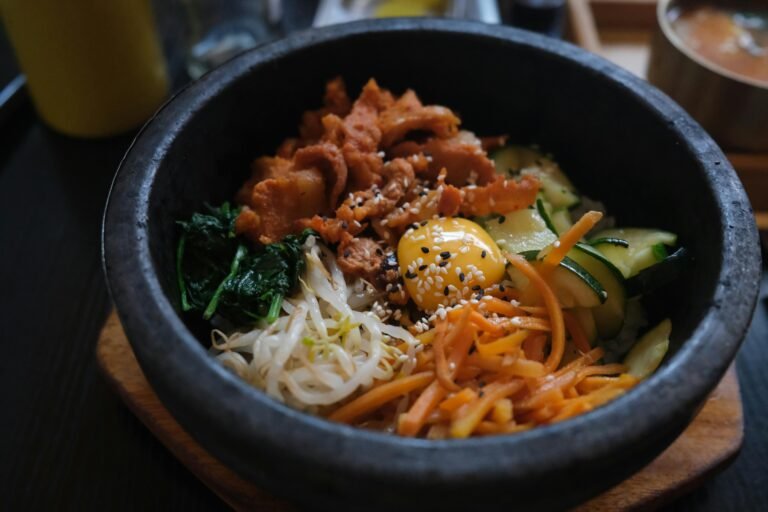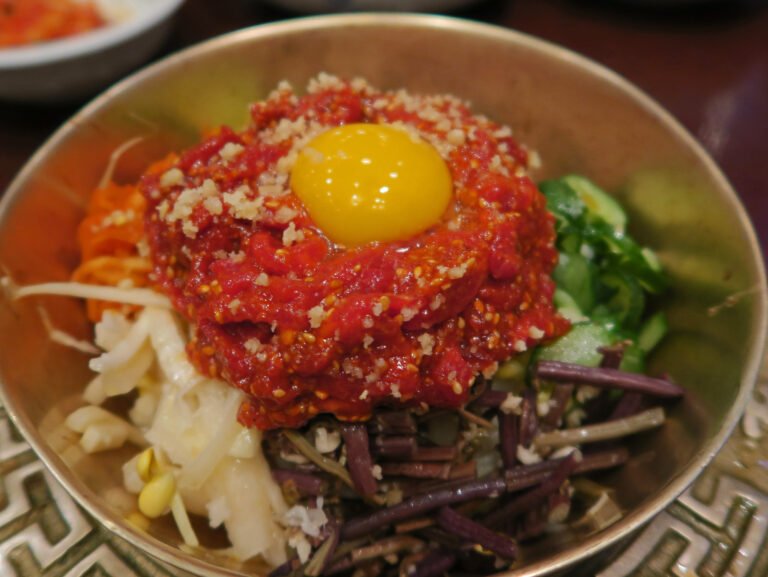Bibimbap (everything you need to know in 2025)

Looking for information about Bibimbap?
I am excited about telling you about Bibimbap as it is the most favorite food I have ever eaten in Korea. No need to recommend eating! I am Gazi and I have been living in South Korea since 2023. I love to explore K-world.
Actually, I did not know about Korean food much more when I arrived and even I did not too much fascinated. After a few days, I got a chance to work with Koran people at a Burger Shop called Burgers Almighty at Shinsegae Departmental Store. A bowl of Bibimbap, came from a shop, which was next to our shop, was my first Bibimbap that I had. Then I simple thing happened to me that I fell in love with Bibimbap. Then I carefully started exploring Korean food.
Table of Contents
ToggleBibimbap Bowl
Bibimbap is significantly popular and is one of the traditional Korean dishes. If you translate into English, then it sounds like “mixed rice”.
Bibimbap bowl consists of warm white rice topped with an assortment of sautéed and seasoned vegetables (known as namul), gochujang (Korean chili pepper paste), soy sauce, or doenjang (a fermented soybean paste). Often, a fried egg and sliced meat (commonly beef) are added. The ingredients are mixed together thoroughly before eating.
I cannot wait to have again😋😋😋 . If you want to have with me, just drop me an email: hello@unravelkorea.com 🤧. I will give you a treat.

Bibimbap Ingredients/ Bibimbap Recipe
- 5 cups cooked short-grain rice
- 12 ounces soybean sprouts, washed and drained
- 8 ounces of spinach blanched and washed with the excess water squeezed out by hand
- 1 large carrot
- 1 large red bell pepper
- 1 large zucchini
- 1 English cucumber
- 3 to 4 green onions, chopped
- ½ pound fresh lean cut of beef (fillet mignon, flank steak)
- 4 ounces fernbrake (gosari), fresh or soaked from ½ ounce dried gosari (details below)
- 1-ounce dried bellflower roots (doraji), soaked in cold water for 18 to 24 hours.
- 4 eggs
- kosher salt
- vegetable oil
- toasted sesame oil
- toasted sesame seeds
- garlic
- soy sauce
- honey (or sugar)
- Korean hot pepper paste (gochujang)
If you want to know more about recipe: My Korean Kitchen here.
Bibimbap Sauce
Bibimbap has mainly three types of Sauce. Sauces make Bibimbap more delicious.
- Classic Gochujang Bibimbap Sauce – Korean chili pepper paste, often mixed with a bit of sesame oil and sugar for added flavor.
- Doenjang Bibimbap Sauce – Fermented soybean paste (less common but used in some variations)
- Soy Sauce – Sometimes used in place of or alongside gochujang for additional depth of flavor
Bibimbap Vegetables (Namul)
Spinach: Blanched and seasoned with sesame oil, garlic, and salt
Bean Sprouts: Blanched and seasoned similarly to spinach
Zucchini: Julienned and sautéed with a pinch of salt
Carrots: Julienned and sautéed or blanched
Mushrooms: Shiitake or other mushrooms, sliced and sautéed
Cucumber: Julienned and sometimes lightly salted or pickled
Fernbrake (Gosari): Rehydrated, blanched, and seasoned.
Bibimbap menu
There are lot of choices of Bibimbap, but most famous ones are:
-
Bibimbap With Kalbi Beef Short Ribs
-
Bibimbap With Bulgogi
-
Bibimbap With Pork Belly
-
Bibimbap With Flank Steak
-
Yukhoe Bibimbap
-
Tuna Bibimbap
Check out more: Menu
Frequently Asked Questions (FAQs)
How nutritious Bibimbap is?
The calorie count can vary based on the ingredients used, but it usually contains approximately 500-600 calories, 25-30 grams of protein, and 10-15 grams of fat, and 80-100 grams of carbohydrates.
How many calories are in Bibimbap?
There are approximately 634-640 calories in 1 serving of Bibimbap in Korea.
Joining me for latest travel news, offers, and events
Stay connected on Instagram


